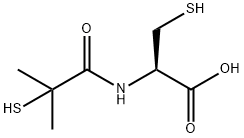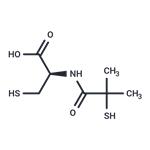Description
Bucillamine is an orally active immunomodulator useful in the treatment of rheumatoid
arthritis. Its potencies in inhibiting collagenase activity and inactivating rheumatoid factor
far exceed those of penicillamine. In man, bucillamine reportedly brings about significant
improvements over placebo in erythrocyte sedimentation, grip power, joint swelling and
duration of morning stiffness.
Manufacturing Process
Preparation of N-(2-benzylmercaptoisobutyryl)-S-benzyl-L-cysteine:
1). 73.9 g of S-benzyl-L-cysteine were dissolved in 700 ml of 1 N sodium
hydroxide solution. The solution was cooled in an ice bath and stirred. 2-
Benzylmercaptoisobutyryl chloride, which was obtained by reacting 63.1 g of
2-benzylmercaptoisobutyric acid with 39.3 g of thionyl chloride, was added
dropwise to this solution. The resulting mixture was then stirred for one hour,
acidified with hydrochloric acid and extracted with ethyl acetate. The extract
was washed with water, dried over sodium sulfate and evaporated to dryness.
The residue was chromatographed on silica gel with benzene/ethylacetate
(1:1) as an eluant. The eluate was evaporated to dryness and an oily residue weighing 46.9 g, representing a yield of 74%, was obtained.
2). The obtained in (1) above were dissolved in 500 ml of liquid ammonia and
21.1 g of metallic sodium were added slowly with stirring. After completion of
reaction, 59.4 g of ammonium chloride were added and thereafter the
ammonia was removed by distillation. Water was added to the residue to
dissolve the solid. The resulting water layer was separated, washed with ethyl
acetate, and acidified with hydrochloric acid under cooling. The precipitates
thus obtained were extracted with ethyl acetate. The extract was washed with
water, dried over sodium sulfate and evaporated to dryness. The product
weighed 43.6 g, representing a yield of 88%. After recrystallization from ethyl
acetate, the desired compound, melting at 139°-140°C, was obtained.
[α]D
25=+32.3° (c=1.0, ethanol).



